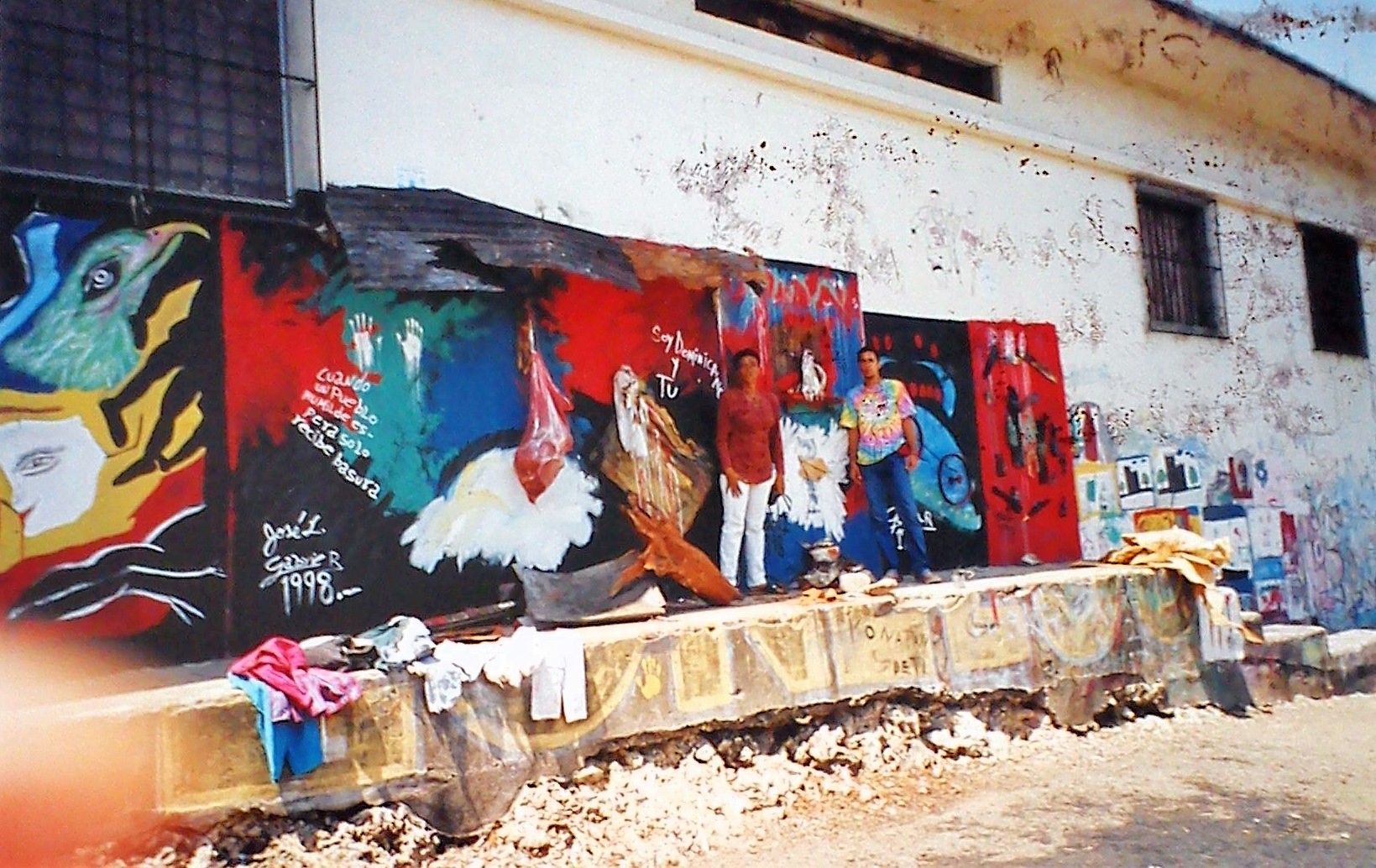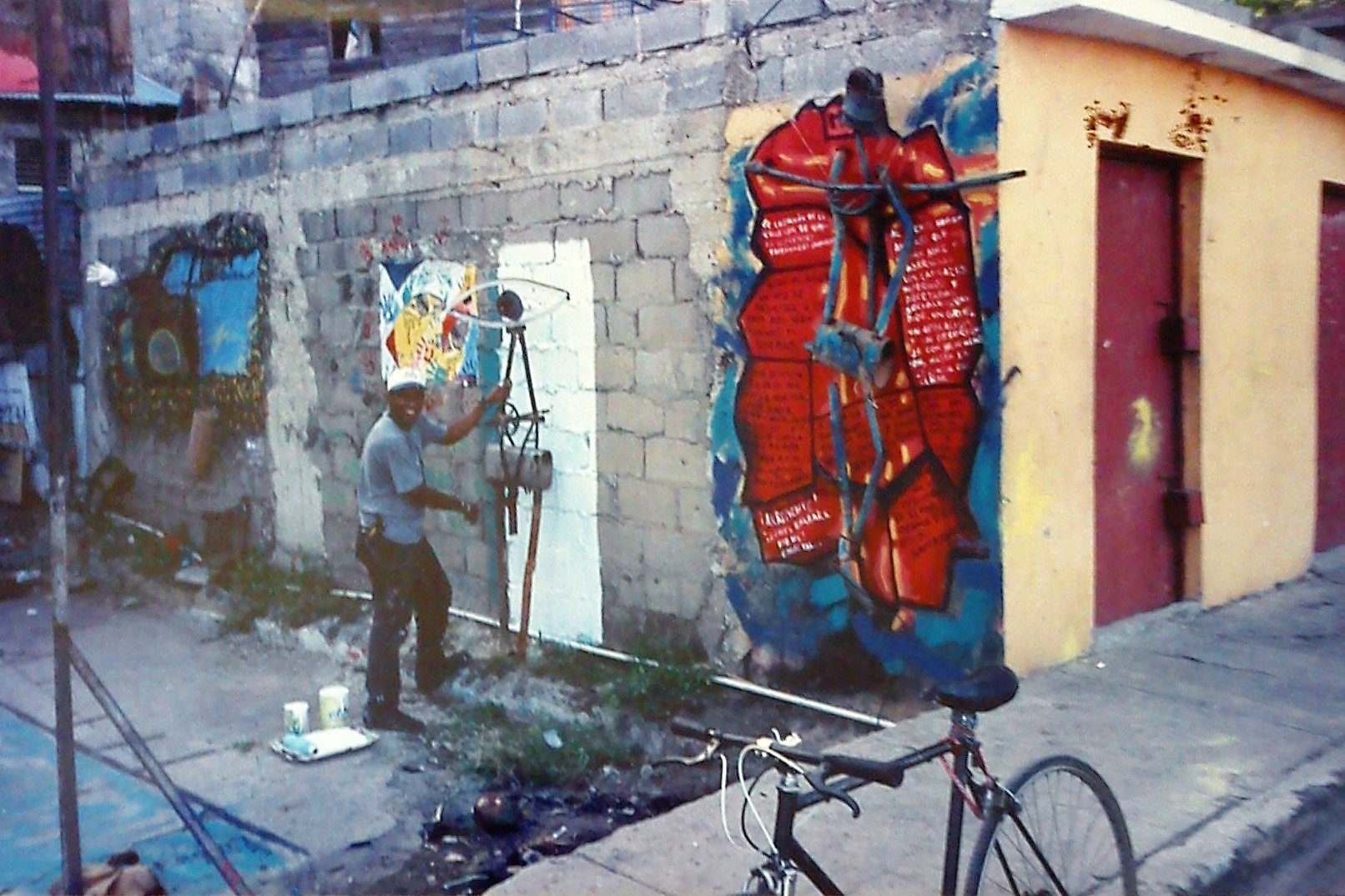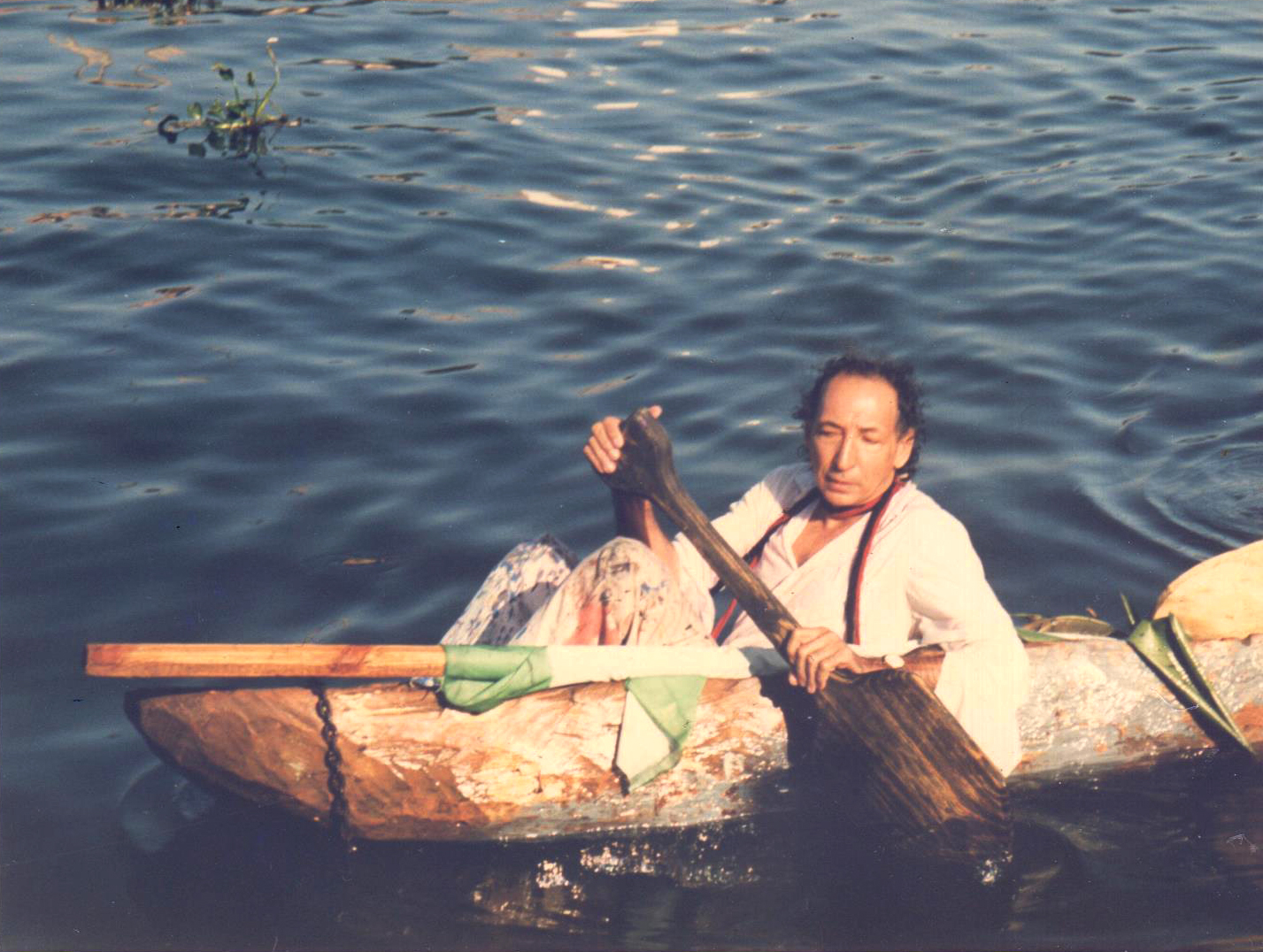"highlight the creative capacity and aesthetic value of people living in poverty, men, women and children who, despite living at the limit of their subsistence possibilities, preserve an imaginative potential capable of overcoming their deteriorated environment. At the same time, to present professional and amateur artists with the challenge of producing works and exhibiting their creations in a non-museum environment where their undisputed value should theoretically prevail." 7.
From Spectators to Creatives
08/18/2023
The need to eliminate any vestige of the dictatorial ideology led him to summon intellectuals, poets and other artists to bring art, culture and thought to the peripheral neighborhoods of the city, under a maxim that would determine his cultural production forever: to change the spectator people into a creative people.

I came with a project, with a plan, knowing that one could perfectly combine the commitment of artists, of creators, with social and political commitment without losing creativity, originality, experimentation.
In the Caribbean, as in the rest of Latin America, pain is a constant; our histories are written between blood and resistance. Resistance is the action that leads to hope, eternal utopia that keeps us moving. To speak of Silvano Lora in the Dominican Republic is to speak of a mythical character, an artist hero who wanted to build utopia with art and culture.
Silvano was a product of his time: he was born in 1931, at the beginning of the voracious dictatorship of Rafael Leonidas Trujillo and had to go into exile (Paris 1955) for the first time when he was still a boy. It was abroad that he defined the spirit of struggle that would accompany him all his life, and at the same time, his artistic work took shape. The atrocious crimes, the execution of the dictator, the liberation of political prisoners and the experience of cultural management and political activism in Europe, would mark the practices and thinking of this artist.
From the 'Art and Liberation Movement' to the 'Constitutionalist Cultural Front.'
The disappearance of the dictator, for the Dominican nation, meant an opportunity for life; after years of fear, persecution and death, citizens were finally able to gather without fear. This time provided the perfect scenario for the return, as Silvano expressed it well, "The fervor of a hope that became utopia was lived."1 He returned with a plan that left aside the artistic protagonism, but he believed in the synergy between art and politics for social transformation and advocated an avant-garde aesthetic production.
At that time, communism made its way in the continent as an alternative to authoritarian regimes. Silvano was a communist all his life, he developed within the party a cultural platform of thought and creation from which he articulated his projects; there he also cultivated human relations, as well as social connections that would help him in the development of each future cultural initiative.
Communism molded in Silvano the way of making art and managing culture, and there he found the possibility of the new world.
In this context the Art and Liberation Movement (1962) was born. Silvano, a charismatic man, kept in touch with friends and colleagues during his exile. Upon his return, the reunion and the need to eliminate any vestige of the dictatorial ideology led him to summon intellectuals, poets and other artists to bring art, culture and thought to the peripheral neighborhoods of the city, under a maxim that would determine his cultural production forever: to change the spectator people into a creative people.
The Art and Liberation Movement had several interventions in marginalized neighborhoods of the city, where exhibitions, recitals, murals, film forums, and theatrical presentations were held. The collective brought out three manifestos, which in Silvano's own words signified the commitment of the artistic collective. He was always aware of the power of words and the need to think about art, so not only were the manifestos written, but also Art and Liberation theorized about the social function of art and the role of artists in their society, as shown in this excerpt from the first manifesto:
"Our creative gesture will reflect everything that moves us. We are sensitive to beautiful marble, bronze, and champagne, but much stronger is the impression left by the humiliating misery to which the Dominican people are subjected."[2]
The first of all the Movement's activities defined a work methodology that would be replicated in future cultural interventions developed by Silvano. In this activity, a poetic recital, an exhibition, an on-site mural, and several workshops for the community members took place; it was a multidisciplinary, communitarian, collective, inclusive, and pedagogical activity.
Despite the success of the Movement, it was forced to transform after the coup d'état against Juan Bosch (1963). The members were persecuted for their ideas and this forced them to disperse. It was not until 1965, in the midst of the Revolution, and understanding the transcendental moment, that Silvano regrouped part of the Movement and turned it into the Frente Cultural Constitucionalista,3 or the command of the artists during the war. Alfredo Pierre4 reveals to Quisqueya Lora5 that her father convinced Montes Arache, revolutionary leader, to support the artists. He agreed and provided them with paints, papers, brushes and a house that served as a base and creative workshop. The Front came out with a manifesto entitled "We are also the people," in which they declared their commitment to the ideals of the struggle: "Our art is a particular category of the armed struggle. Because the armed struggle does not consist only in the use of the rifle, but also of the ideas that move the rifle."6
In the Cultural Front, artists created posters, banners and murals used to inspire and motivate the population and insurgents in the struggle. With this they unified and made visible the discourse of the revolution. This collective experience marked a paradigm in Dominican artistic practice, as for the first time art left the exclusivity of the small workshops of the elites and took to the streets alongside the excluded.
During the Revolution, graphic workshops were opened where artists and interested people learned the techniques; the only commitment with the workshop was to create graphic material that could be used as inspiration or propaganda for the constitutionalist struggle. This Front carried out theater and dance presentations, poetry recitals, and film forum evenings in theaters and streets of the constitutionalist zones. It is important to clarify that the combatants of the Revolution of 65 in the Dominican Republic were, in their great majority, young civilians—men and women—who acquired essential battle knowledge during the months of the struggle (April-September). The work of the Constitutionalist Cultural Front was transcendental, for motivating and serving as a school of thought for the combatants and bringing them closer to culture.
The Marginal Biennial
After the Revolution, Silvano spent eleven years in exile in Panama, where he worked and developed cultural initiatives with political discourse. He returned to the country at the end of the 1970s. Since then, he promoted innovative projects as head of the cultural facet of the Communist Party, which involved intellectuals, writers, other artists, and young people whom he educated and trained in ways of being and doing art, citizenship, and cultural management.

In 1990, Silvano organized the first version of the Marginal Biennial. This had two essential purposes: first, to be a criticism of the class exclusion of the state biennial, which left out countless artists, and second, to prevent the eviction of hundreds of families in the first marginal neighborhood in the country, Santa Barbara. This was a community on the outskirts of the Colonial City, which in 1992 the authorities sought to eliminate in order to build an avenue.
Silvano was warned of this situation and paid special attention to the case of an old shack occupied by a handful of families in overcrowded conditions. As always, he mobilized immediately, took advantage of the state biennial and invited the artists who were not accepted to exhibit their works in the shack. Silvano, who embraced the aesthetics of Arte Povera, fervently believed in the possibility of creation regardless of resources or conditions. Loraine Ferrand, who was his pupil, says that one of the master's essential teachings was to always give something back to the community. Everyone who worked with him had to contribute to the collective welfare, and this contribution, for the youngest of his followers, often translated into being multipliers of knowledge or popular educators. The resources for their activities came, not infrequently, from their own capital, from the exchange or barter of their works for materials and donations from friends and colleagues.

Although the previous experience with Arte y Liberación became the ideal model, the Marginal Biennial brought together different artistic disciplines, intellectuals, established artists, new artists and community members in a great political and cultural action. Silvano developed a work process based on human connections; his charm won followers wherever he went and his example motivated hundreds to follow in his footsteps. Thus, important figures of the intellectual and artistic circuit from all over the country participated in the six versions of the Marginal Biennial.
That first version, with exhibitions of recognized and unknown artists, recitals, plays, performances, concerts and workshops, may be the largest political intervention in Dominican history that used culture as a means of struggle and transformation, which is why the Santa Barbara neighborhood is still there.
In Silvano's words, the First Marginal Biennial sought to
Protest/Performance Against the Celebration of the 500th Anniversary of the Discovery of the Americas. [8]
In the Dominican Republic, the figure of the native peoples has been distorted, the official history showed the native culture as weak and submissive societies at the service of the conquerors. In recent times, various groups have been working on the discursive reparation of our aboriginal ancestors. Silvano was a forerunner in this regard and once again used art as a means of protest. In 1992, the country hosted the celebration of the 500th anniversary of the so-called "discovery of the Americas."
As a historical nucleus, the country received in the Colonial City the replicas of the Spanish caravels that made the transatlantic voyage. For the reception of the ships, an elaborate event was prepared with the participation of national and international authorities. That day, while the authorities were waiting for the ships, a small canoe (cayuco)9 with two men on board—Silvano and an artisan friend (Pachiro)—approached the replicas with fruits and flowers. The action interrupted the sumptuous protocol and immediately mobilized the maritime authorities, who in an attempt to intercept them overturned the canoe, leaving its crew adrift. In view of this incident, all those present took their eyes off the event and concentrated on the men in the water.
In Quisqueya Lora's words, this action "sought to make visible the vanquished, the native peoples who were the great victims of this tragic encounter. The action aimed to make present the voice of the natives, systematically silenced by the official programs that had been coordinated between Spain and the Dominican Republic."10

This action transcended the collective memory of the Dominican people and became a reference and precedent of the Dominican decolonial struggle.
The projects described above were not the only initiatives of this artist, Silvano traveled throughout the country, part of Latin America and Europe, sowing seeds in many who today are replicators of his way of being and doing. His maxim, "to turn the people into creators," changed the way of doing art in the Dominican Republic and opened a possibility for many excluded people in our society. Silvano transcended as a synonym of struggle, integrity, and solidarity for those most in need. He invested everything he was in the creation of a more just and equitable society for all, where the arts and culture were his weapons. His legacy is an echo that continues to form artists at the grassroots of the people.
Bibliography
Arte y liberación. Exposición. Manifiesto por un arte revolucionario 2. 20 octubre 1962. Archivo Silvano Lora.
Silvano Lora, “Primera Bienal Marginal”, Listín Diario. 1 marzo de 1992.
Quisqueya Lora, “Protesta/Performance contra la celebración del Quinto Centenario Del Descubrimiento de América 1992”. (Texto de exhibición) (2020).
Manifiesto, Frente Cultural. Colección Silvano Lora. Santo Domingo, 1965.
Aniova Prandy, “Silvano Lora: Arte, militancia y colectivismo”. Revista Plenamar (Agosto 2021). (Digital)
Diego Renart, “La Bienal Marginal: Silvano Lora y su bienal de todos”, Revista ONTO (1era edición). (Enero 2018) p.98.
Carlos Sangiovanni (director), Silvano Lora: el compromiso del arte. [Documental; DVD] S.P. (2007)

